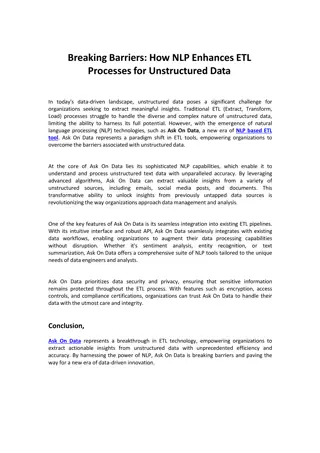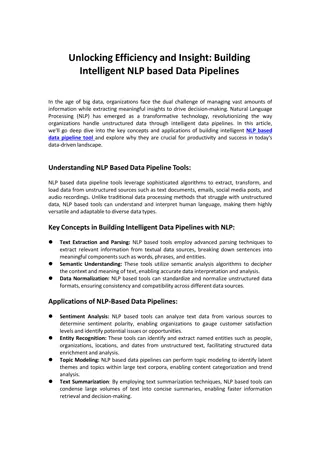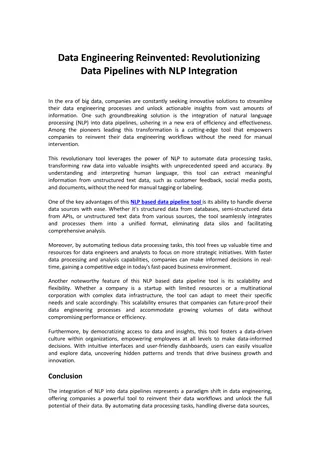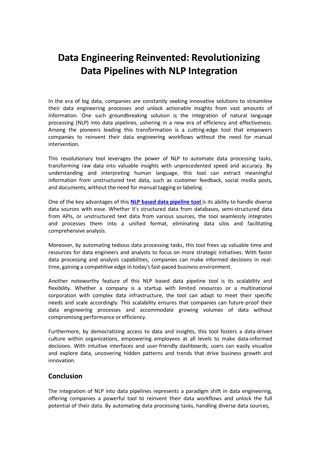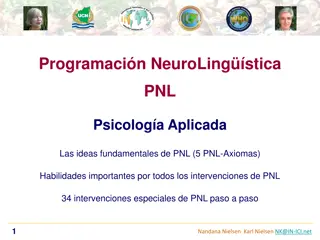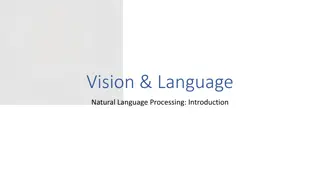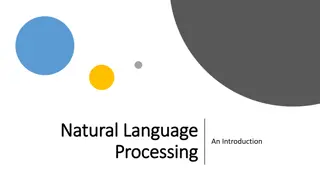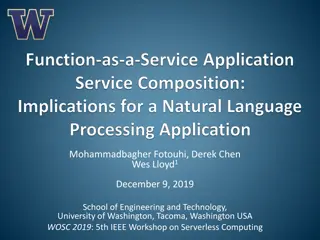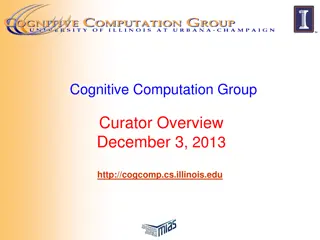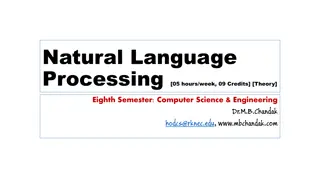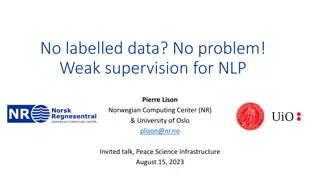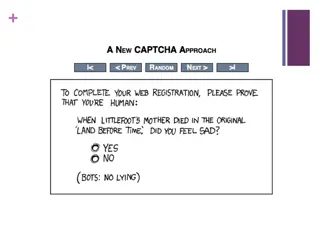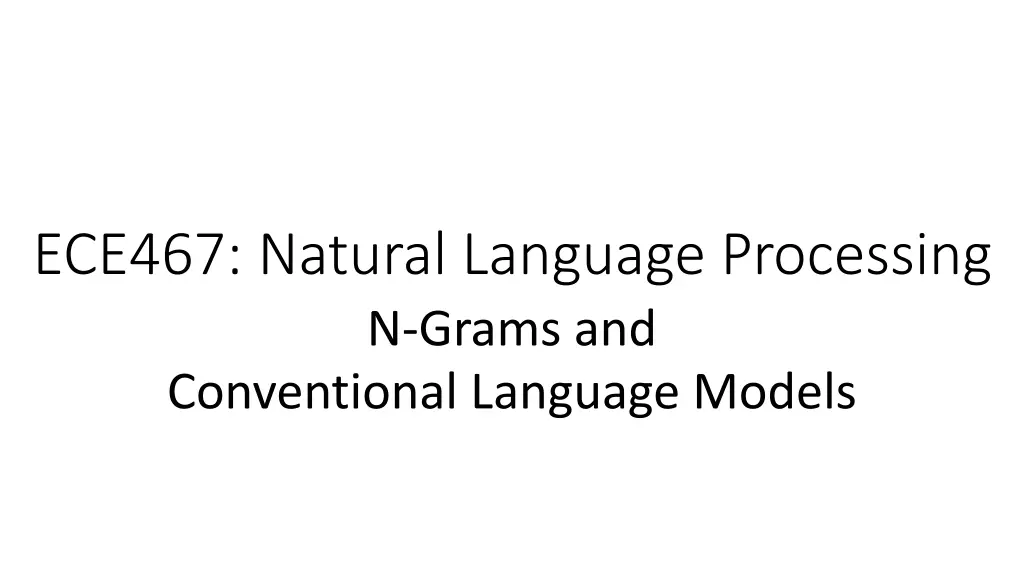
N-Gram Language Models and Applications
Explore N-gram language models, their significance in natural language processing, and applications such as speech recognition, machine translation, and more. Learn about corpora and the importance of understanding words in text processing.
Download Presentation

Please find below an Image/Link to download the presentation.
The content on the website is provided AS IS for your information and personal use only. It may not be sold, licensed, or shared on other websites without obtaining consent from the author. If you encounter any issues during the download, it is possible that the publisher has removed the file from their server.
You are allowed to download the files provided on this website for personal or commercial use, subject to the condition that they are used lawfully. All files are the property of their respective owners.
The content on the website is provided AS IS for your information and personal use only. It may not be sold, licensed, or shared on other websites without obtaining consent from the author.
E N D
Presentation Transcript
ECE467: Natural Language Processing N-Grams and Conventional Language Models
N-grams and N-gram Models This topic is largely based on Chapter 3 of the textbook, titled "N-gram Language Models" An N-gram (or n-gram) is a sequence of N tokens Common N-grams include 2-grams (bigrams) and 3-grams (trigrams) Single tokens are sometimes called unigrams In NLP, the tokens are commonly words, but they could be characters, word embeddings, etc.; we'll assume words for now An N-gram model computes the probabilities of each possible final token of an N-gram given the previous N- 1 tokens Therefore, in NLP, an N-gram model is often used to estimate the probability of a word given the N-1 previous words The previous edition of the book stated: " the N-gram model is one of the most important tools in speech and language processing." This sentence has been dropped in the current edition, probably because many tasks that used to partially rely on N-gram models now use deep learning techniques instead The current edition of the textbook states that N-gram models "are an important foundational tool for understanding the fundamental concepts of language modeling"
Applications of N-gram Models Applications that may rely on N-gram models include: Speech recognition Machine translation Spelling correction Grammatical error correction Augmentative communication POS tagging Natural language generation Predictive text input (e.g., for cell phones) Modern approaches for some of these tasks now use deep learning approaches instead
Corpora Obtaining counts of things in a natural language can rely on a corpus (the plural is corpora) For example, the Brown corpus is a million-word collection of 500 written texts from different genres (newspaper, fiction, non-fiction, academic, etc.) The Brown corpus was assembled at Brown University in 1963-1964 The Brown corpus has 61,805 wordform types, 37,851 lemma types, 1 million wordform tokens An example for spoken English is the Switchboard corpus of telephone conversations between strangers was collected in the early 1990s The Switchboard corpus contains 2,430 conversations averaging 6 minute each The textbook distinguishes between the number of types, or distinct words, in a corpus (a.k.a. the vocabulary size) from the number of tokens in the corpus (i.e., the total count of wordforms) The Switchboard corpus has about 20,000 wordform types and about 3 million wordform tokens (both audio files and transcribed text files with time alignment and other metadata are available) The previous edition of the textbook mentions a study by Gale and Church estimating that the vocabulary size grows with at least the square root of the number of tokens In later topics, we will learn about the Penn Treebank (which Cooper now also has access to!)
Words Revisited As mentioned in our previous topic, we need to decide what counts as a word before we apply tokenization and other steps of text normalization For some tasks, it might make sense to treat punctuation as separate words (e.g., this can help with sentence segmentation and POS tagging) Some tasks are usually case-sensitive (e.g., POS tagging), but others are not (e.g., speech recognition); for case-insensitive tasks, all letters can be converted to the same case Consider the spoken utterance "I do uh main- mainly business data processing" (taken from the Switchboard corpus) Words like "uh" and "um" are fillers or filled pauses The broken off word "main-" is a fragment These are two kinds of disfluencies; some tasks remove disfluencies, some don't We also learned in our last topic that for some tasks, it can be helpful to perform lemmatization or stemming Of course, when counting N-grams and computing N-gram probabilities based on a corpus, we need to use the same text normalization techniques that will be used for applications later
Estimating N-gram Probabilities Recall that an N-gram model computes the probabilities of each possible final token of an N-gram given the previous tokens One simple method for computing such N-gram probabilities (the probability of a word given some history) is to take a simple ratio of counts Example: P("the" | "its water is so transparent that")=C("its water is so transparent that the") C("its water is so transparent that") The book suggests using a web search engine to compute an estimate for this example However, the result of doing this would give you an estimate close to 1 because, many of the hits relate to this example from the book! Book: "While this method of estimating probabilities directly from counts works fine in many cases, it turns out that even the web isn't big enough to give us good estimates in most cases." In general, the bigger N is, the more data you need to achieve reasonable N-gram estimates
The Chain Rule We are not going to cover probability as a separate topic in this course, but we'll introduce notations and formulas as necessary Some shorthand that we will use includes: P(Xi= "the") is P(the) w1 wnis w1 P(X = w1, Y = w2, Z = w3, , W = wn) = P(w1, w2, , wn) The chain rule of probability is: P(X1 Xn) = P(X1)*P(X2 X1)*P(X3 X1 The chain rule can easily be applied to words; i.e., we can compute the probability of a sequence of words by multiplying together multiple conditional probabilities (and one prior probability) This does not help us if we cannot obtain accurate estimates of the conditional probabilities This is typically the case with NLP; many sequences of words have never occurred before, but they should not be estimated to have 0 probability nor w1:n n 2)* *P(Xn X1 n 1) = k=1 k 1) P(Xk|X1
Applying N-gram Models A bigram model would estimate the probability of a word given all previous words to be the probability of a word given the preceding word This is an example of a Markov assumption A trigram model would look two words into the past In general, an N-gram model looks N-1 tokens into the past According to the bigram model (for words): n n P w1 P(wk|wk 1) k=1 When k=1, it is common to use the unigram probability for the first word; another possibility will be discussed shortly
Some Machine Learning Terminology Learning N-gram probabilities from a corpus is an example of machine learning (ML) In general, parameters of statistical models can be trained using a training set and can be evaluated using a test set (we'll talk more about evaluating N-gram models shortly) There should be no overlap between the training set and test set; doing so could introduce huge inaccuracies and make a model seem much better than it really is For models that include hyperparameters (we ll see an example soon), a development set (a.k.a. tuning set or validation set) which can be used to set the hyperparameters The textbook sometimes uses the term held-out set to mean validation set However, I have seen other sources more commonly use the term held-out set or hold- out set to be synonymous with test set Another possibility for setting hyperparameters is to use cross-validation
Maximum Likelihood Estimates The simplest way to learn bigram, or more general N-gram, probabilities from a training corpus is called maximum likelihood estimation (MLE) For bigrams of words, the equation that can be used is: C(wn 1wn) wC(wn 1w)=C(wn 1wn) The example we saw earlier is a specific example for a larger N-gram More generally, MLE sets the parameters of a model in such a way as to maximize the probability of observations It is possible to derive the formula above, for bigram models, given this definition For more general N-grams, the MLE formula becomes: P wnwn N+1:n 1 =C(wn N+1:n 1wn) P wnwn 1 = C(wn 1) C(wn N+1:n 1) When computing probabilities for N-grams, it is important that your training set reflect the nature of the data that you are likely to see later (this is true for parameter estimation and ML in general) If you do not know in advance what future data will look like, you may want to use training data that mixes different genres (e.g., newspaper, fiction, telephone conversation, web pages, etc.)
Start-of-sentence & End-of-sentence Tokens Although the MLE formula may seem simple and intuitive, there are a few things I want to point out First, as pointed out in the textbook, the final simplification occurs because the sum of all bigram counts that start with a given word must be equal to the unigram count for that word This may seem to ignore the possibility that wn-1matches the final word of the sequence we are using to compute statistics However, as the current draft of the textbook points out, for things to work out appropriately, we must include both start-of-sentence tokens ("<s>") and end-of-sentence tokens ("</s>") It is common to process one sentence at a time in NLP; if we are not doing this, we could more generally use special start and end symbols at the start and end of each document or span of text being considered With these extra symbols, wn-1(the second to last word in a bigram or other N-gram) will never be the same as the final word of the sequence being used to compute probabilities These extra symbols will ensure that the probability estimates for all possible words ending an N-gram, starting with some particular sequence, add up to one Additionally, this avoids the need to use a unigram probability at the start of the sequence when we compute its probability
Example of Bigram Estimates Here is an example from the textbook of three sentences that can be used to compute bigram estimates: Here are some of the bigram estimates based on this example:
Natural Language Generation N-grams can also be used to for natural language generation (NLG) Depending on whether start-of-sentence markers were used, you may need to start by randomly generating a unigram Then, you can randomly generate one or more bigrams; then one or more trigrams; etc. For example, if you are primarily using trigrams, you are repeatedly generating a new word based on the previous two words Each word is chosen randomly, with words weighted according to their trigram probabilities based on the previous two words When an end-of-sentence marker is generated, the process ends The figures on the next two slides show examples of automatically generated text after training N-gram models on different corpora (the figure numbers changed a bit in the current iteration of the draft) In the first example, the N-gram models were trained on works of Shakespeare In the second example, the N-gram models were trained on a Wall Street Journal corpus Note that for machine learning tasks, in general, it is important that the training corpus reflects the nature of the data that you expect to see later
Unknown Words For some tasks, you might have a lexicon indicating all possible words in advance; this implies a closed vocabulary More typically, unknown words, a.k.a. out-of-vocabulary (OOV) words, are allowed An open vocabulary system accounts for potential unknown words One common method is to start with a fixed vocabulary list and treat every other word in the training set as a pseudo-word, <UNK> Another common method is to replace words that have a frequency below some specified cutoff in the training set with <UNK> Alternatively, we can choose a vocabulary size, V, and use the top V words, accordingly to frequency, from the training set as the vocabulary Once the vocabulary has been set, and other tokens have been converted to <UNK>, we can treat <UNK> just like all other tokens to estimate probabilities
Language Models A language model (LM) is a model that assigns a probability to a sequence of natural language text The N-gram model that we have been learning about is an example of an LM In theory, you can multiply all the probabilities associated with the N- grams in the text (for a chosen value of N) Later in the course, we will see how word embeddings and variants of recurrent neural networks can be used to produce more effective LMs
Evaluating Language Models One way to evaluate the performance of a language model (the best way, according to the textbook) is to embed it in another application (e.g., a machine translation system) and evaluate its performance This approach is called extrinsic evaluation; extrinsic evaluation can involve a lot of time and effort Alternatively, intrinsic evaluation uses a metric to evaluate the quality of a model (in this case, a language model) independent of any application Often, improvements using an intrinsic measure correlate with improvements using an extrinsic measure An intrinsic evaluation is based on a test set Ideally, the test set should not be looked at before the evaluation, and the model being evaluated should only be applied to the test set once As mentioned earlier, if we need to tune hyperparameters, we can use a validation set (that can be used multiple times) In principle, the way to evaluate a language model with intrinsic evaluation is to calculate the probability assigned by the model to the test set (although we will soon discuss pragmatic complications related to this) This can be compared to probabilities assigned to the test set by other language models (in theory, better language models will assign higher probabilities)
Log Probabilities One issue is that if many probabilities are multiplied together, the result would likely be stored as 0 due to finite precision and numerical underflow Instead, we therefore add log probabilities The base doesn t really matter, as long as it is consistent, but let's assume it is e Also recall that the log of a product is equal to the sum of the log of its parts Using log probabilities avoids 0s that may otherwise result due to precision issues Additionally, it also makes computation quicker, since we are doing additions instead of multiplications The precomputed probability estimates for N-grams can be stored as log probabilities directly Therefore, there is no need to compute the logarithms when evaluating the language model If we want to report an actual probability at the end, we can raise e to the power of the final log probability; e.g., p1 * p2 * p3 * p4 = e(log p1 + log p2 + log p3 + log p4)
Perplexity In practice, instead of reporting probabilities assigned by LMs, it is common to instead report a metric called perplexity, sometimes abbreviated as PP Perplexity is closely related to the information-theoretic notion of cross- entropy (we will not discuss this in this course) Perplexity is the inverse probability of a sequence of words normalized by the number of words: PP(W) = P(w1w2 wN)-1/N After the chain rule: PP W = P(wi|w1 wi 1) 1 N i=1 N If we are using a bigram model, this becomes: PP W = 1 N i=1 N P(wi|wi 1) The higher the probability of the word sequence, the lower the perplexity
Perplexity Example The textbook describes an example in which they trained unigram, bigram, and trigram models on text from the Wall Street Journal The training set contained approximately 38 million words, with a vocabulary size of about 20,000 They then evaluated each model on a separate test set from the Wall Street Journal containing approximately 1.5 million words The perplexities of the unigram, bigram, and trigram models were 962, 170, and 109, respectively Recall that lower perplexity indicates a better result It should be intuitive that the trigram model leads to the lowest perplexity, since it uses more context At the same time, I think it is important to understand that the probabilities themselves become less accurate with increasing N, because the data is sparser
Smoothing MLE produces poor estimates when counts are small due to sparse data, especially when counts are zero When evaluating a language model on a dataset, if any N-gram occurs that never occurred in the training set, it would be assigned 0 probability (and the log probability would be undefined) Smoothing techniques are modifications that address poor estimates due to sparse data Laplace smoothing (e.g., add-one smoothing) is a simple method that adds a constant (e.g., 1) to all counts For example, for unigram probability estimates, we have: PLaplace(wi) = (ci+ 1) / (N + V) We can view smoothing as discounting (lowering) some non-zero counts in order to obtain the probability mass that will be assigned to the zero counts The changes due to add-one smoothing are too big in practice You could try adding a fraction less-than one (this is a more general form of Laplace smoothing), but choosing an appropriate fraction is difficult (in practice, it can be chosen based on a development set) The book discussed better alternatives; it mentions Good-Turing smoothing and discusses Kneser-Ney smoothing in detail I personally worked on a smoothing method when I interned for Ken Church as a graduate student called bins (the evaluation was an example of extrinsic evaluation)
Backoff and Interpolation In a backoff approach, if the N-gram probability estimate is 0, you use the (N-1)-gram estimate In interpolation, we mix the probability estimates from various N-gram models For example, with simple linear interpolation, to compute trigram estimates, we use: P wnwn 2wn 1 = 1P wnwn 2wn 1 + 2P wnwn 1 + 3P(wn) The ?s must sum to 1 for the values to be valid probabilities These ?s are examples of hyperparameters, mentioned earlier; generally, the ?s can be computed based on a development corpus The textbook also mentions more sophisticated methods of linear interpolation (we will not cover those)

